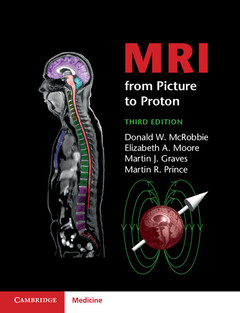Description
MRI from Picture to Proton (3rd Ed., Revised edition)
Authors: McRobbie Donald W., Moore Elizabeth A., Graves Martin J., Prince Martin R.
This new edition includes the latest on quantitative MR, safety, multi-band excitation, Dixon imaging and MR elastography.
Language: English
Subject for MRI from Picture to Proton:
91.52 €
In Print (Delivery period: 14 days).
Add to cart
Publication date: 04-2017
400 p. · 19x24.6 cm · Paperback
400 p. · 19x24.6 cm · Paperback
Description
/li>Contents
/li>Biography
/li>
MR is a powerful modality. At its most advanced, it can be used not just to image anatomy and pathology, but to investigate organ function, to probe in vivo chemistry, and even to visualise the brain thinking. However, clinicians, technologists and scientists struggle with the study of the subject. The result is sometimes an obscurity of understanding, or a dilution of scientific truth, resulting in misconceptions. This is why MRI from Picture to Proton has achieved its reputation for practical clarity. MR is introduced as a tool, with coverage starting from the images, equipment and scanning protocols and traced back towards the underlying physics theory. With new content on quantitative MRI, MR safety, multi-band excitation, Dixon imaging, MR elastography and advanced pulse sequences, and with additional supportive materials available on the book's website, this new edition is completely revised and updated to reflect the best use of modern MR technology.
Glossary; 1. MR: what's the attraction?; Part A. The Basic Stuff: 2. Early daze: your first week in MR; 3. Seeing is believing: introduction to image contrast; 4. Lost in the pulse sequence jungle?; 5. The devil's in the detail: pixels, matrices and slices; 6. What you set is what you get: basic image optimisation; 7. Improving your image: how to avoid artefacts; 8. Spaced out: spatial encoding; 9. Getting in tune: resonance and relaxation; 10. Let's talk technical: MR equipment; 11. Ghosts in the machine: quality control; Part B. The Specialist Stuff: 12. Acronyms anonymous I: spin echo; 13. Acronyms anonymous II: gradient echo; 14. The parallel universe: parallel imaging and novel acquisition techniques; 15. Go with the flow: MR angiography; 16. A heart-to-heart discussion: cardiac MRI; 17. It's not just squiggles: in vivo spectroscopy; 18. To BOLDly go: fMRI, perfusion and diffusion; 19. Making it count: quantitative MRI; 20. But is it safe? Bio-effects; 21. Where are we going now?; Appendix: maths revision; Index.
Donald W. McRobbie is Chief Medical Physicist for South Australian Medical Imaging, Adelaide, Australia.
Elizabeth A. Moore manages the Advanced Solutions Department at Philips Healthcare in Eindhoven, The Netherlands.
Martin J. Graves is Consultant Clinical Scientist in the Department of Radiology at Cambridge University Hospitals, Cambridge.
Elizabeth A. Moore manages the Advanced Solutions Department at Philips Healthcare in Eindhoven, The Netherlands.
Martin J. Graves is Consultant Clinical Scientist in the Department of Radiology at Cambridge University Hospitals, Cambridge.
© 2024 LAVOISIER S.A.S.




